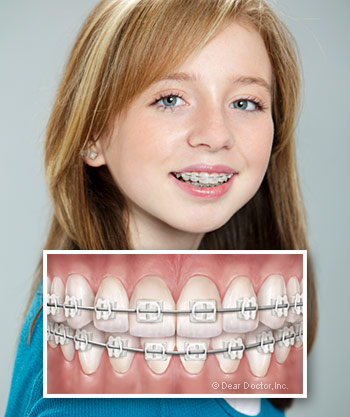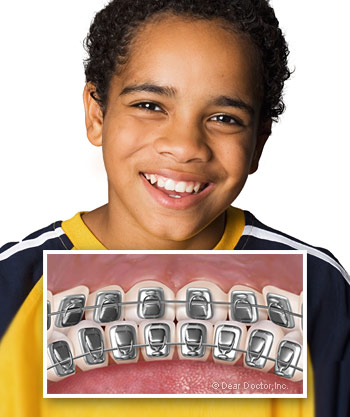Types of Braces
For the vast majority of orthodontic patients, wearing fixed appliances (commonly called braces) will be a major part of treatment — and those braces, for the most part, will be the familiar silvery-metal type. But while they're still quite popular, traditional-looking metal braces are no longer the only game in town! Let's have a look at some of the options available in orthodontic appliances.
First, we should distinguish between fixed and removable appliances. Fixed appliances like braces are attached to the teeth by metal bands or special cement. They aren't normally taken off until treatment is complete. Removable appliances, such as clear aligners, are typically worn some 22 hours per day, but may be easily taken off as needed. While clear aligners can be effective in treating mild to moderate orthodontic problems, fixed appliances are generally needed for more comprehensive treatment.
Titanium Braces
 Titanium brackets take advantage of the unique properties of titanium. They are significantly smaller than other comparable braces. Obviously, the smaller the size, the less obtrusive the braces appear. Other benefits of titanium braces include:
Titanium brackets take advantage of the unique properties of titanium. They are significantly smaller than other comparable braces. Obviously, the smaller the size, the less obtrusive the braces appear. Other benefits of titanium braces include:
- Supreme biocompatibility (due to titanium composition)
- Superior reliability (due to titanium properties)
- Hygienic advantages (due to titanium strength and small size)
- More fun (with changeable colored ties)
Ceramic Braces
 Clear ceramic braces are a new variation on the traditional system that provides a far less noticeable method of treatment. They use the same components as traditional braces — except that the brackets on the front side of the teeth are made of a translucent ceramic material that blends in with the tooth's natural color. This system has become a favorite for adults (including some well-known celebrities) because, unless you look closely, it's hard to notice they're there.
Clear ceramic braces are a new variation on the traditional system that provides a far less noticeable method of treatment. They use the same components as traditional braces — except that the brackets on the front side of the teeth are made of a translucent ceramic material that blends in with the tooth's natural color. This system has become a favorite for adults (including some well-known celebrities) because, unless you look closely, it's hard to notice they're there.
Several types of ceramic braces are currently available, and the technology is constantly improving. Their aesthetic appeal is undeniable... but there are a few tradeoffs. The ceramic brackets can be less durable than their metal counterparts; plus, while the brackets themselves don't stain, the elastic bands that attach them to the archwire do (however, these are generally changed each month.) Ceramic braces also cost more than metal — but for many people, the benefit of having an inconspicuous appliance outweighs the costs.
Lingual Braces
 While ceramic braces certainly offer a less conspicuous look, there is still another system that allows fixed braces to be truly invisible. In some situations, special appliances called lingual braces can be placed on the tongue side of the teeth. They work the same way other metal braces do — but even though they're made of metal, they can't be seen, because they're hidden behind the teeth themselves!
While ceramic braces certainly offer a less conspicuous look, there is still another system that allows fixed braces to be truly invisible. In some situations, special appliances called lingual braces can be placed on the tongue side of the teeth. They work the same way other metal braces do — but even though they're made of metal, they can't be seen, because they're hidden behind the teeth themselves!
Lingual braces aren't the proper treatment for every orthodontic condition. Special training is required to install them, and they're significantly more expensive than standard braces. They also generally require a bit more time for the wearer to get used to them, and they may slightly prolong treatment. But if you want the least visible type of fixed appliance — and if you're a candidate for this treatment option — then lingual braces may be just what you're looking for.
WildSmiles
 Express yourself with WildSmiles braces, the fun alternative to traditional braces! With WildSmiles, patients have a choice of several shapes and styles to customize their braces to fit their personality. Wild Smiles brackets are made from quality stainless steel. They also can incorporate color elastic ties for added individuality. The patented designs can be mixed and matched to give everyone a truly unique smile.
Express yourself with WildSmiles braces, the fun alternative to traditional braces! With WildSmiles, patients have a choice of several shapes and styles to customize their braces to fit their personality. Wild Smiles brackets are made from quality stainless steel. They also can incorporate color elastic ties for added individuality. The patented designs can be mixed and matched to give everyone a truly unique smile.
